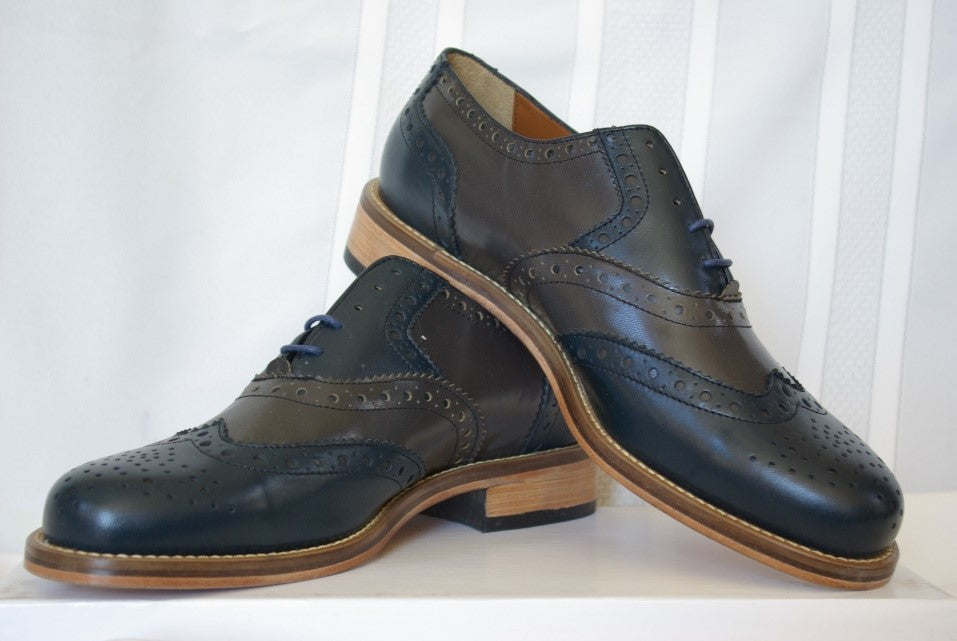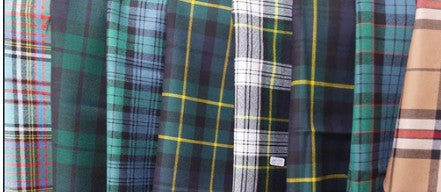
Ode to the Ghillie Brogue
By Bruce Griffith
The ghillie brogue started out as footwear that would drain water and dry quickly. In the very early days of Scottish footwear the ghillie brogue was made out of animal hides. In the original ghillie brogue designs, the laces were above the ankle so the shoes wouldn't get stuck in the mud. The shoe had a pattern of fine holes perforating the leather, known as brogueing.

There's an early reference to Scottish Highlanders making and wearing similar shoes. These were described in 1542, John Elder writing of the dress of Highlanders to King Henry VIII:
"...we can not suffir bair footide...after we have slayne redd deir, we flaye of the skyne, bey and bey, and settinge of our bair foote on the insyde therof, for neid of cunnynge shoemakers, by your Graces pardon, we play the sutters; compasinge and mesuringe so moche therof, as shall retche up to our ancklers, pryckynge the upper part thereof also with holis, that the watrer may repas wher it entris, and stretchide up with a stronge thwange of the same, meitand above our saide ancklers, so, and pleas your noble Grace, we make our shoois: Therefor, we using suche maner of shoois, the roghe hairie syde outwart..."

Early 1600’s saw references to ghillie brogues and the name Pampooties. Pampooties are raw-hide shoes, which were formerly made and worn on the Aran Islands of County Galway, Ireland.

In the 17th century the Squirarchy had heels added and merged the styles of the Cuaran and Ghillie. These hardier shoes were ideal for deer stalking, hunting and fishing. Circa 1640 a shawl tongue was added with a fringe to lend a touch of elegance. It was thought Irish landowners started to decorate their shoes with patterned sequence of holes. In the original shoes the holes served a pragmatic purpose i.e. to allow water to flow through. For good luck the designs incorporated coded symbols. As soon as the style became associated with the gentry the holes became more decorative features (Vass & Molnar, 1999). Later when the holes only served for decorative purposes leather uppers were rubbed with melted candle wax (or tallow) to improve waterproofing. The brogue became refined without losing its sturdiness as the style crossed over into main fashion.
The Brogue (derived from the Gaelic bróg (Irish), bròg (Scottish) "shoe")[1][2] is a style of low-heeled shoe or boot traditionally characterised by multiple-piece, sturdy leather uppers with decorative perforations (or "broguing") and serration along the pieces' visible edges.[3] Modern brogues trace their roots to a rudimentary shoe originating in Ireland that was constructed using untanned hide.[4]
The ghillie style of full brogue has no tongue, to facilitate drying, and long laces that wrap around the leg above the ankle and tie below the calf to facilitate keeping the tie clear of mud. Despite the functional aspects of their design, ghillies brogues are most commonly seen as a component of traditional, formal Scottish dress and are worn primarily for social occasions.
Fast forward a few hundred years from these humble beginnings to modern day. Ghillie brogues are marketed and sold around the world and the Scottish heritage lives on. However have we really evolved very far? The modern day ghillie brogue still pays homage to its humble roots of style and history. But have manufacturers been able to meet the individual needs of a worldwide market. The marketplace has been morphing to where the demands on the ghillie brogue shoe have become more a life style shoe than style. Any doubt of my last statement is quickly dissolved after a visit to an adult beverage tent at the end of a 5 mile parade.
The problem is most manufacturers of ghillie brogues have not looked at the global market and the needs of different areas of the world. Most manufacturers as churning out “one size fits all” brogues and marketing on a global scale. It is no secret that different parts of the world have different make ups of how feet look and fit. North American feet are generally wider across the ball of the foot and a little narrower in the heel, thus requiring a shoe made on a last (foot form) that supports the needs of a North American client.

To help understand the global marketplace better Avriel has recently done some surveys with our marketplace. The results really showed us we are going in the right direction. In the piping and drumming world it is also no secret we are servicing an aging population that are wanting and wishing to maintain their activities of piping and drumming. Shoes become even more important to being able to thrive in these activities. An ill-fitting shoe will fatigue the foot far quicker than most pipers would like and in extreme cases actually doing long term damage cutting off circulation to parts of the foot.


In one of our surveys we actually asked the question “are you diabetic? Do you where orthotics or have other foot issues that need to be addressed in your choice of shoes “. In parts of our great country the response was over 50% of responses said YES, they either have foot issues or need to where orthotics. A telling tail that until recently had never been on the radar of ghillie brogue suppliers. If you think I am out of line on these observations, ask any piper that cannot get his custom orthotic in his brogues with his thick hose. Do you know any pipers that have said “I want to play, but I just can’t march anymore”.
A couple years ago after recognizing the Scottish and Piping community was under serviced in life style shoes, Avriel started to manufacture shoes to change the world. Avriel is producing ghillie brogues in 6 widths. We make them narrow and we make them wide and even super wide. No other company has taken on this challenge on this scale. Avriel is also the only company “world wide” producing a proper extra depth orthotic ghillie brogue with removable liners to insert custom orthotics.



Maintaining life style at any age is important. Maintaining life style in comfort is important at any age.
Never judge a person until you walk a mile in their shoes.
For more information go to www.avriel.com or contact bruce@avriel.com
Sources of information
https://en.wikipedia.org/wiki/Brogue_shoe
http://forums.bobdunsire.com/forums/showthread.php?t=130660
http://allaboutshoes-toeslayer.blogspot.ca/2014/04/a-short-history-of-brogues.html
https://en.wikipedia.org/wiki/Pampootie
Pictures
https://www.google.ca/search?q=the+history+of+the+ghillie+brogue&source=lnms&tbm=isch&sa=X&ved=0ahUKEwjumoPGzO7YAhVIwmMKHYqVDLUQ_AUICygC&biw=1280&bih=908#imgrc=C9t0fKJ3DHzQrM:
https://www.google.ca/search?q=pampooties&source=lnms&tbm=isch&sa=X&ved=0ahUKEwjImO7X8O7YAhUF6WMKHST2A0cQ_AUICigB&biw=1280&bih=908#imgrc=kGNjc_WEuWK-9M:
https://www.google.ca/search?q=pampooties&source=lnms&tbm=isch&sa=X&ved=0ahUKEwjImO7X8O7YAhUF6WMKHST2A0cQ_AUICigB&biw=1280&bih=908#imgrc=2ga1Dor6SvWuBM:
https://www.google.ca/search?q=shoe+last&source=lnms&tbm=isch&sa=X&ved=0ahUKEwjZucfV8-7YAhUJymMKHVB9AU8Q_AUICigB&biw=1280&bih=908#imgrc=7KQt0fotaClScM:
https://www.google.ca/search?q=shoe+last&source=lnms&tbm=isch&sa=X&ved=0ahUKEwjZucfV8-7YAhUJymMKHVB9AU8Q_AUICigB&biw=1280&bih=908#imgrc=ab-gLH3WrHsZPM:













